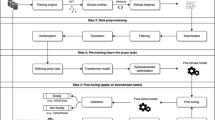Abstract
The goal of this study is to present an improved code selection algorithm (BCSA) for fault prediction. The contributions mainly contain three parts. The first part is on the extension of the horizontal input in the code selection algorithm (CSA). We propose that the horizontal input is also the prediction for the next coming event, not only for recalling. Thus, BCSA is able to recall and predict alternately. The second part is on the extension of the generic minicolumnar function. We propose that the function of a minicolumn is to be a k-winner-take-all competitive module (CM) and all active cells (the overall input is 1) should be chosen as winners within a CM. The third part is on the improvement of the competition mechanism. In BCSA, the winners are directly chosen with only one round competition. Thus, computing the input’s similarity G is unnecessary. BCSA is applied to analyze the disaster of the space shuttle Challenger which is a well-known example of fault prediction. Compared to other methods, the result of BCSA is specific, robust and independent of the parameters.







Similar content being viewed by others
References
Cottrell M, Gaubert P, Eloy C, François D, Hallaux G, Lacaille J, Verleysen M (2009) Fault prediction in aircraft engines using self-organizing maps. In: WSOM ’09 Proceedings of the 7th international workshop on advances in self-organizing maps, pp 37–44
Nguyen TT, Nguyen TN, Phuong TM (2011) Topic-based defect prediction. In: Proceedings of the 33rd international conference on software engineering, pp 932–935
Qin LN (2011) Software reliability prediction model based on PSO and SVM. In: Proceedings of the international conference on consumer electronics, communications and networks, pp 5236–5239
Dalal SR, Fowlkes EB, Hoadley B (1989) Risk analysis of the space shuttle: pre-Challenger prediction of failure. J Am Stat Assoc. doi:10.2307/2290069
Draper D (1993) Assessment and propagation of model uncertainty. In: Proceedings of the fourth international workshop on artificial intelligence and statistics, pp 497–509
Lavine M (1991) Problems in extrapolation illustrated with space shuttle O-ring data. J Am Stat Assoc. doi:10.1080/01621459.1991.10475132
Martz HF, Zimmer WJ (1992) The risk of catastrophic failure of the solid rocket boosters on the space shuttle. Am Stat. doi:10.1080/00031305.1992.10475846
Zhang L, Ma J, Wang Y, Pan S (2011) PSO-BP neural network in reservoir parameter dynamic prediction. In: Proceedings of CIS, pp 123–126
Mountcastle VB (1997) The columnar organization of the neocortex. Brain. doi:10.1093/brain/120.4.701
Olshausen BA, Field DJ (1996) Emergence of simple-cell receptive field properties by learning a sparse code for natural images. Nature. doi:10.1038/381607a0
Hoyer PO, Hyväinen A (2002) A multi-layers sparse coding network learns contour coding from natural images. Vis Res. doi:10.1.1.57.7504
Hawkins J, George D (2011) Hierarchical temporal memory-concepts, theory, and terminology. Numenta Incorporation. http://www.numenta.com/htm_overview/education/NumentaHTMConcepts.pdf. Accessed 16 June 2011
Rinkus GJ (2010) A cortical sparse distributed coding model linking mini-and macrocolumn-scale functionality. Front Neuroanat. doi:10.3389/fnana.2010.00017
Starzyk JA, He H (2009) Spatio-temporal memories for machine learning: a long-term memory organization. IEEE Trans Neural Netw. doi:10.1109/TNN.2009.2012854
Starzyk JA, He H (2007) Anticipation-based temporal sequences learning in hierarchical structure. IEEE Trans Neural Netw. doi:10.1109/TNN.2006.884681
Hubel DH, Wiesel TN (1962) Receptive fields, binocular interaction and functional architecture in the cat’s visual cortex. J Physiol 160(1):106–154
Hubel DH, Wiesel TN (1968) Receptive fields and functional architecture of monkey striate cortex. J Physiol 195(1):215–243
Lennie P (2003) The cost of cortical computation. Curr Biol. doi:10.1016/S0960-9822(03)00135-0
Sun K, Lee S (2008) Power system security pattern recognition based on phase space visualization. Electr Util Deregul Restruct Power Technol. doi:10.1109/DRPT.2008.4523546
Aharon M, Elad M, Bruckstein A (2006) K-svd: an algorithm for designing overcomplete dictionaries for sparse representation. IEEE Trans Signal Process. doi:10.1109/TSP.2006.881199
Labusch K, Barth E, Martinetz T (2008) Simple method for high-performance digit recognition based on sparse coding. IEEE Trans Neural Netw. doi:10.1109/TNN.2008.2005830
Pattee HH (1973) Hierarchy theory: the challenge of complex systems. George Braziller, California
Changizi MA (2001) Universal scaling laws for hierarchical complexity in languages, organisms, behaviors and other combinatorial systems. J Theor Biol. doi:10.1006/jtbi.2001.2346
George D (2008) How the brain might work: a hierarchical and temporal model for learning and recognition. Dissertation, Stanford University
Rivest RL, Sloan R (1994) A formal model of hierarchical concept learning. Inf Comput. doi:10.1006/inco.1994.1081
Simon HA (1981) The sciences of the artificial. MIT Press, Massachusetts
George D, Hawkins J (2009) Towards a mathematical theory of cortical micro-circuits. PLoS Comput Biol. doi:10.1371/journal.pcbi.1000532
Bobier BA, Wirth M (2008) Content-based image retrieval using hierarchical temporal memory. In: Proceeding of the 16th ACM international conference on multimedia, pp 925–928
Hawkins J, Dubinsky D, Ahmad S (2010) Hierarchical temporal memory including HTM cortical learning algorithms. Numenta Incorporation. http://www.numenta.com/htm_overview/education/HTMCorticalLearningAlgorithms.pdf. Accessed 1 September 2011
Guyonneau R, Vanrullen R, Thorpe SJ (2004) Temporal codes and sparse representations: a key to understanding rapid processing in the visual system. J Physiol. doi:10.1016/j.jphysparis.2005.09.004
Yang Q, Parvin B (2003) High-resolution reconstruction of sparse data from dense low-resolution spatio-temporal data. IEEE Trans Image Process. doi:10.1109/TIP.2003.812389
Hawkins J, Blakeslee S (2004) On intelligence. Times Books, New York
Hawkins J, Blakeslee S (2007) Why can’t a computer be more like a brain. IEEE Spectr 44(4):20–26
Rinkus GJ (1996) A combinatorial neural network exhibiting both episodic memory and generalization for spatio-temporal patterns. Dissertation, Boston University
DO HA, DO HA (1949) The organization of behavior. Wiley, New York
Wang D, Arbib MA (1990) Complex temporal sequence learning based on short-term memory. Proc IEEE. doi:10.1109/5.58329
Author information
Authors and Affiliations
Corresponding author
Additional information
This work was supported by National Basic Research Program of China (973 Program) under Grant 2011CB302201 and National Nature Science Foundation of China under grant No. 60931160441.
Rights and permissions
About this article
Cite this article
Kuang, Y., Yi, Z. & Zhang, L. An improved code selection algorithm for fault prediction. Neural Comput & Applic 22, 1763–1772 (2013). https://doi.org/10.1007/s00521-012-1203-z
Received:
Accepted:
Published:
Issue Date:
DOI: https://doi.org/10.1007/s00521-012-1203-z




